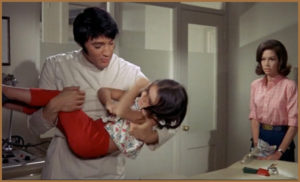For many, 1988’s Rain Man is often considered the first depiction of autism in film. However, autistic characters have graced the silver screen long before the idea of a cross country trip between an autistic savant and his brother was ever conceived. In fact, according to Wikipedia, Autistic portrayals can be traced back as far as 1969, a year when the world was greeted by not one, but two films featuring autistic characters: ‘Change of Habit’ and ‘Run Wild, Run Free’.
Although I’m aware Wikipedia is hardly the most reliable of sources, today I wanted to give the online encylopedia of misinformation a chance and explore what it means for the origins of autistic characters, if we consider that the very first appearance of autism in film, is that of little Amanda from the final Elvis Presely feature film: Change of Habit.

(Photo Credit: Ritchie Yorke)
What is Change of Habit about?
Released one year before “The King” would forever kill his cool image by sporting a white bejewelled jumpsuit, Change of Habit can also be considered another pivotal moment in Elvis’ career, as he went from starring in films portraying him as the late 60’s dream boy and moved him into a role with more gravitas: John Carpenter, a doctor in a run-down city, which struggles with drugs, poverty and racism.
Despite Elvis being marketed as the star of Change of Habit, most of the plot focuses on Mary Tyler Moore’s character, Sister Michelle, a nun who goes undercover to help spread the word of the Lord (I guess I must have missed the part in the bible where Jesus told his disiples to go out and hoodwink him some new followers).
The film touches on many different themes such as religion and identity, as well as those previously mentioned and although it’s approach to these topics is extremely dated, I would be lying if I said I didn’t enjoy watching the one and a half hour musical/drama/comedy mash-up.
Change of Habit has a unique charm which comes with age and, although I’m probably alone in enjoying its aimless narrative, somehow, somewhere, between the discussions of interest debt and an Elvis singalong to make the autistic girl smile on a merry go round, I got hooked to this critically panned memory of the past. I won’t be recommending this one time any time soon, but I can definitely see myself revisiting it in the future.

What Change of Habit gets RIGHT about Autism.
Considering how Change of Habit includes the lines ‘she’s as black as the ace of spades’ and ‘you look like you were dipped in maple syrup’, it wouldn’t be a stretch to say my expectations for its portrayal of autism were fairly low. Perhaps this is why, when autistic character, Amanda, finally appears midway into the film, I was so pleasantly surprised.
Amanda is a young girl, perhaps 6 or 7, when her aunty brings her to Elvis’ clinic, as she believes Amanda’s non-responsive nature is a sign that she is deaf. Elvis is quick to accept this, however, Moore’s character objects; stating that she believes Amanda is autistic.
Although what comes later entirely contradicts what I am about to say, I believe that this shows that some serious research went into Change of Habit’s depiction of autism. Even after 50 years it is still common place for people to misdiagnose autism as deafness or impaired hearing. This, along with Amanda’s realistic repetative body movements probably explain why I was so excited to chalk this depiction up as a win. However…
What Change of Habit gets WRONG about Autism
After Amanda is diagnosed with autism, things start to go downhill for Change of Habit. With an almost immediate example of this coming from the film’s description of autism, which states: ‘sometimes when a child is rejected very early in life, they curl inside themselves and shut out the whole world, as if they are trying to punish the rest of us along with themselves’ – a description which, by today’s standards, is pure nonsense.
To be fair, Change of Habit was going off 50-year-old research so, as ridiculous as this sounds, it’s important to note that this isn’t any fault of the film itself but something which was genuinely believed at the time. It’s no wonder then why, both the doctor and the nun, prescribe young Amanda ‘love and affection’ for her autism, along with the more severe treatment of ‘Rage Reduction’.

For anyone unaware of ‘Rage Reduction’, this was a highly controversial treatment in the 60’s and 70’s, which basically forced someone to get their anger out, in the hope of draining them from it and yes, it’s just as horrific as it sounds. In Change of Habit, Amanda’s toys are taken from her and she is pinned down, yelled at and forced to express herself, in a scene which lasts for an uncomfortably long time.
This only gets worse when Amanda comes out of her treatment showing no signs of autism. Something which worryingly made me consider how many unfortunate autists must have suffered, as a result of the promotion of this torturous technique at the time of the film’s release.
Despite its undeniably upsetting nature, I think that Change of Habit’s representation of autism is something to be valued, as it serves as a time capsule about how wrong our understanding of the condition was, and doesn’t gloss over how cruel some of the ‘treatments’ were. Of course it’s inexcusable that the film depicts these treatments as successful. However, as this was the belief during that time period you cannot blame a single movie for what the world now knows in hindsight.

Carry on the Conversation:
Not the most positive note to end on today, so let’s try and turn this around in the comments. Which autistic character from TV/Film/Books do you enjoy the most? I’ve recently had a discussion on Twitter, where I spoke about the possibility that Jack Gellar (Ross and Monica’s Dad from Friends) is autistic and if he is, you can be sure that he is my number one!
As always, I can also be found on Twitter @AutismRevised and via my email: AutisticandUnapologetic@gmail.com.
If you like what you have seen on the site today, then show your support by liking the Autistic & Unapologetic Facebook page. Also, don’t forget to sign up to the Autistic & Unapologetic newsletter (found on the side bar on laptops and underneath if you are reading this via mobile) where I share weekly updates as well as a fascinating fact I have found throughout the week.
Thank you for reading and I will see you next Saturday for more thoughts from across the spectrum.
(Photo Credit for all pictures featured: Universal Pictures)


